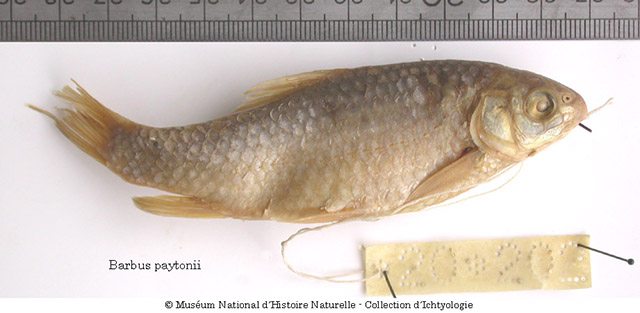| Cyprinidae (Minnows or carps), subfamily: Torinae |
| 25 cm SL (male/unsexed) |
|
benthopelagic; freshwater, |
| Africa: Oued Oum Er-Rbia and Oued Tensift in Morocco (Ref. 94477). |
|
Dorsal spines (total): 0-0; Dorsal soft rays (total): 13-13; Anal spines: 0-0; Anal soft rays: 9-10. Diagnosis: Two pairs of long barbels; 31-38 scales in the lateral line and 13-17 scales around the least circumference of the caudal peduncle; dorsal fin longer than anal fin and less than 15% of the length of its last unbranched ray is flexible; dorsal profile of head straight (Ref. 94477).
Description: The body is of moderate height and without a nuchal hump; the head is triangular with almost straight dorsal and ventral profile; the head length is shorter than the body depth; the mouth is subterminal with two pairs of long barbels; the eyes are in the anterior half of the head and relatively big (Ref. 94477). The dorsal fin is long and strongly ossified and less than 15% of the length of its last unbranched ray is flexible; its last unbranched ray is as long as or longer than the head; it usually has 4 unbranched and 9 branched rays; the anal fin usually has 3 unbranched and 6-7 branched rays; it does not reach the caudal fin origin (Ref. 94477). It has 31-38 scales in the lateral line, usually 5.5-6.5 scales above the lateral line, 4.5-6.5 below the lateral line, and 13-17 scales around the least circumference of the caudal peduncle (Ref. 94477). The pharyngeal teeth count is -4.3.2; the pharyngeal teeth are hooked at their tips (Ref. 94477).
Colouration: Live specimens are silvery with an olive tinge and orange fins (Ref. 94477). Ethanol-preserved specimens are yellow-brown, the back is darker than the belly and flanks (Ref. 94477). |
| Found only in the lower and middle course of big rivers (Ref. 94477). |
|
Critically Endangered (CR); Date assessed: 17 May 2021 (A3c) Ref. (130435)
|
| harmless |
Source and more info: www.fishbase.org. For personal, classroom, and other internal use only. Not for publication.

